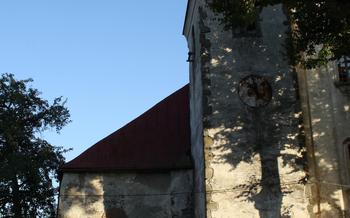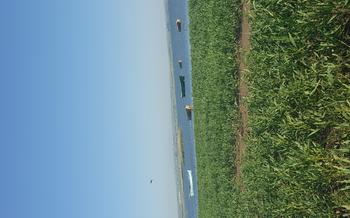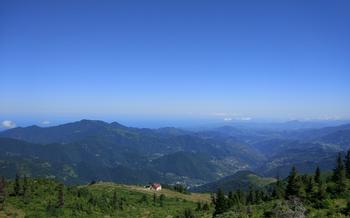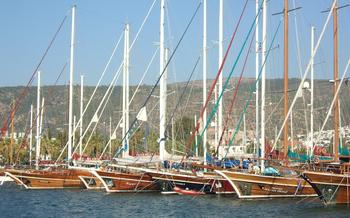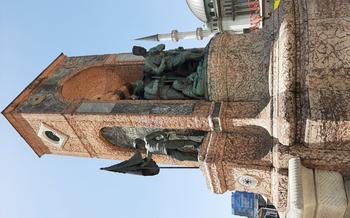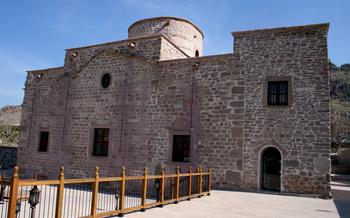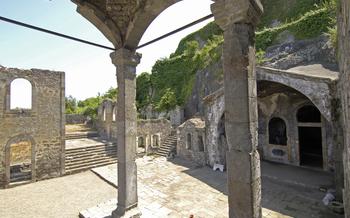
The Leka Monastery
- The Leka Monastery: A Hidden Gem in Balıkesir
- Location and Getting There
- Historical Background
- Architectural Marvels
- Religious Significance
- Cultural Heritage
- Must-See Highlights
- Exploring the Surroundings
- Tips for Visitors
- Photography Opportunities
- Local Cuisine and Dining
- Accommodation Options
- Events and Festivals
- Accessibility and Facilities
- Insider Tip: Unveiling the Secrets of Leka Monastery
The Leka Monastery: A Hidden Gem in Balıkesir
Lost amidst the serene landscapes of Balıkesir, Turkey, lies a hidden gem that whispers tales of history, faith, and architectural brilliance. It is the Leka Monastery, an ancient sanctuary that has stood the test of time, inviting travelers to delve into a world of Byzantine artistry, religious devotion, and cultural heritage.
The Leka Monastery holds immense significance for the Greek Orthodox community, serving as a spiritual beacon for centuries. Its origins can be traced back to the Byzantine period, where it became a prominent center of religious worship and pilgrimage. Dedicated to the Virgin Mary, the monastery exudes a sense of sanctity, inviting visitors to immerse themselves in its rich spiritual atmosphere.
In terms of architectural grandeur, the Leka Monastery showcases a remarkable blend of Byzantine and local influences. Its church building stands as a testament to the intricate craftsmanship of its era, boasting well-preserved frescoes, mosaics, and decorative elements that narrate biblical stories and symbolic meanings.
With its historical significance, architectural marvels, and religious fervor, the Leka Monastery emerges as a must-visit destination for travelers seeking a deeper connection to history, culture, and spirituality. Embark on a journey to this hidden treasure, where every stone whispers secrets from a bygone era, and the spirit of faith lingers in the air.
Location and Getting There
The Leka Monastery is conveniently located in the Balıkesir province of Turkey, making it accessible from major cities in the region. Situated approximately 45 kilometers from Balıkesir city center, the monastery can be reached via a scenic drive through picturesque landscapes. Visitors can opt for a private vehicle or take advantage of the well-connected public transportation system. Regular buses and minibuses depart from Balıkesir bus station, offering a comfortable and affordable mode of transport. The journey takes about an hour, providing an opportunity to admire the surrounding countryside. Once you arrive at the monastery, ample parking space is available for visitors' convenience, ensuring a hassle-free start to your exploration.
Historical Background
The Leka Monastery boasts a rich and storied past that dates back to the Byzantine era, with its origins shrouded in mystery. Founded in the 11th century, the monastery served as a pivotal religious center for the region, playing a significant role in the establishment of Christianity in the area. Its strategic location on a hilltop overlooking the surrounding countryside further solidified its importance, making it a formidable stronghold.
Throughout its history, the Leka Monastery has been closely associated with the Greek Orthodox Church, serving as a spiritual sanctuary for the local Greek Orthodox community. Over the centuries, it has undergone periods of prosperity and decline, facing challenges such as conquests and invasions. Despite these trials, the monastery has remained a steadfast symbol of faith, continuously attracting pilgrims and visitors seeking spiritual solace and connection.
In recent years, the Leka Monastery has undergone extensive restoration efforts, aiming to preserve its architectural heritage and ensure its continued existence for generations to come. These efforts have paid dividends, with the monastery now standing as a testament to the enduring power of faith and the resilience of humanity.
Architectural Marvels
The Leka Monastery boasts an impressive array of architectural features that showcase the influence of Byzantine architecture. The church building, the centerpiece of the monastery, features a basilica plan with three naves separated by rows of columns. The narthex, an enclosed porch at the entrance, is adorned with intricate carvings and decorative elements.
The church's interior is adorned with stunning frescoes and mosaics that depict religious scenes and figures. These intricate artworks display a mastery of technique and a deep understanding of Byzantine iconography. The walls and ceilings are covered in vibrant colors and gold leaf, creating a sense of awe and wonder.
The monastery also features a number of unique architectural details that set it apart from other Byzantine churches. The octagonal dome, supported by four massive columns, is a striking feature that dominates the skyline. The bell tower, located at the western end of the church, is a later addition that displays Ottoman architectural influences.
The Leka Monastery's architecture is a testament to the skill and artistry of the Byzantine builders. The harmonious blend of different architectural elements creates a visually stunning and spiritually uplifting space that continues to inspire visitors to this day.
Religious Significance
The Leka Monastery holds immense religious significance as a place of worship and pilgrimage for the Greek Orthodox community. It has been a sanctuary for devout believers seeking spiritual guidance and solace for centuries. The monastery's serene atmosphere and sacred ambiance invite visitors to connect with their faith and experience a sense of tranquility.
Religious ceremonies and traditions are still actively practiced within the monastery walls, preserving the rich heritage of the Greek Orthodox Church. Visitors can witness these rituals and gain insights into the spiritual practices and beliefs of the community. The monastery serves as a living testament to the enduring power of faith and devotion.
Cultural Heritage
The Leka Monastery stands as a testament to the rich cultural heritage of the region. Its Byzantine architecture, with its intricate mosaics and frescoes, reflects the artistic and religious traditions of the Eastern Roman Empire. The monastery has played a crucial role in preserving these traditions, not only through its physical presence but also through its ongoing religious ceremonies and practices.
Beyond its religious significance, the Leka Monastery has also contributed to the local culture and identity. It has been a center of education and learning for centuries, and its monks have played an important role in shaping the intellectual and spiritual development of the region. The monastery has also been a source of inspiration for local artists and writers, who have found beauty and meaning in its architecture and surroundings.
The monastery is also associated with a number of historical events and legends. According to local tradition, the monastery was founded by a Byzantine emperor who was saved from a shipwreck by the Virgin Mary. Another legend tells of a hidden treasure that is buried somewhere on the monastery grounds. These stories have added to the monastery's mystique and have made it a popular destination for pilgrims and tourists alike.
The Leka Monastery's cultural significance extends beyond religious boundaries. It is a symbol of the region's rich history and heritage, and it continues to inspire and fascinate visitors from all over the world.
Must-See Highlights
The Narthex: Enter through the impressive narthex, a covered porch adorned with intricate frescoes and mosaics. Admire the vibrant colors and detailed depictions of religious scenes that tell stories from the Bible.
Scenic Views: The monastery is perched on a hill, offering breathtaking panoramic views of the surrounding countryside. Take a moment to soak in the beauty of the lush green valleys, rolling hills, and distant mountains.
Well-Preserved Frescoes: Explore the various chapels and chambers within the monastery to discover a treasure trove of well-preserved frescoes. These stunning paintings depict religious figures, saints, and biblical narratives. Marvel at their artistic mastery and the vivid colors that have stood the test of time.
Unique Architectural Details: Pay attention to the intricate carvings and decorative elements that adorn the monastery's walls, columns, and arches. From delicate moldings to intricate stonework, each detail adds to the monastery's unique character and charm.
Exploring the Surroundings
While visiting the Leka Monastery, take the opportunity to explore the enchanting surroundings that offer a blend of natural beauty and historical charm. Just a short distance from the monastery, history buffs can delve into the past at the ancient city of Daskyleion, once the capital of the Bithynian kingdom. Nature enthusiasts can embark on invigorating hiking trails that wind through picturesque landscapes, offering breathtaking views of the surrounding countryside. For a relaxing afternoon, pack a picnic and find a secluded spot amidst the tranquil surroundings, enjoying a leisurely meal with stunning vistas as your backdrop.
Tips for Visitors
To make the most of your visit to the Leka Monastery, consider the following tips:
-
Timing is key: The best time to visit the monastery is during the shoulder seasons (spring and autumn) when the weather is pleasant and there are fewer crowds.
-
Plan your visit: Allocate at least half a day to explore the monastery and its surroundings. This will give you ample time to appreciate the architecture, admire the frescoes, and soak in the serene atmosphere.
-
Dress respectfully: As a place of worship, visitors are expected to dress modestly. Avoid wearing shorts, tank tops, or revealing clothing.
-
Observe religious customs: Be respectful of ongoing religious ceremonies and traditions. Maintain silence and refrain from taking photos or using flash during these times.
Photography Opportunities
The Leka Monastery offers a wealth of photo opportunities that will delight photography enthusiasts. Every nook and cranny of the monastery holds a picturesque scene, from the grand exterior to the intricate details of the interior.
Picture-Perfect Spots:
- The Narthex: Capture the impressive narthex with its intricate carvings and stunning frescoes.
- Monastery Courtyard: Photograph the peaceful courtyard with its lush greenery and serene atmosphere.
- Frescoes and Artwork: Focus on the well-preserved frescoes, mosaics, and other artwork that adorn the monastery walls.
- Panoramic Views: Take advantage of the monastery's elevated location to capture breathtaking panoramic views of the surrounding landscapes.
Tips for Stunning Photos:
- Golden Hour Magic: Visit during the golden hours of sunrise or sunset to capture the monastery bathed in warm, ethereal light.
- Composition and Perspective: Experiment with different angles and perspectives to create dynamic and visually appealing compositions.
- Natural Light: Utilize natural light to your advantage. Harsh sunlight can create unwanted shadows, so consider visiting on a cloudy day or using a diffuser.
- Tripod Stability: Use a tripod for stability, especially when capturing low-light shots or long exposures.
Local Cuisine and Dining
While exploring Balıkesir and the Leka Monastery, take the opportunity to indulge in the region's delectable cuisine. The area boasts a rich culinary heritage influenced by Turkish traditions and local flavors.
For a true taste of Balıkesir, try their famous pide, a type of flatbread topped with various ingredients such as cheese, meat, or vegetables. Another must-try is gözleme, a thin pastry filled with spinach, cheese, or potatoes.
To satisfy your sweet tooth, sample the local künefe, a shredded pastry filled with cheese and soaked in syrup. For a refreshing treat, try dondurma, Turkish ice cream, known for its unique texture and flavors.
When dining near the monastery, consider visiting one of the traditional Turkish restaurants in the vicinity. These establishments offer a warm ambiance and an array of dishes cooked with fresh, local ingredients.
Take advantage of the opportunity to enjoy a meal with a view. Many restaurants in the area offer outdoor seating with stunning views of the monastery and the surrounding landscapes.
Don't miss out on the chance to sample local delicacies such as ayran, a yogurt-based drink, or Turkish coffee, brewed using a unique method and served in small cups.
Accommodation Options
For travelers seeking a convenient and comfortable stay near the Leka Monastery, there are several accommodation options available. Numerous hotels and guesthouses in the surrounding area offer a range of amenities and services to cater to different needs and budgets.
To ensure a pleasant and hassle-free stay, it is advisable to book your accommodation in advance, especially during peak tourist seasons. Consider factors such as proximity to the monastery, desired amenities, and budget when making your choice.
Some recommended hotels near the monastery include the Leka Monastery Hotel, which offers stunning views of the surrounding landscapes, and the Balikesir Park Hotel, known for its comfortable rooms and convenient location.
For those seeking a more budget-friendly option, there are several guesthouses and hostels in the vicinity that provide basic but clean and comfortable accommodations. Local guesthouses often offer a unique opportunity to interact with the friendly locals and experience the authentic Turkish hospitality.
Events and Festivals
The Leka Monastery hosts several special events and festivals throughout the year, attracting both pilgrims and tourists. These events offer a unique opportunity to witness the monastery's religious and cultural significance firsthand.
One of the most important events is the annual celebration of the monastery's patron saint, Saint John the Baptist. This festival takes place on January 7th and features a series of religious ceremonies, processions, and traditional dances. Visitors can join the local community in celebrating the saint's life and seeking his blessings.
Other notable events include the Easter celebrations, which draw large crowds of pilgrims to the monastery. During this time, visitors can witness the traditional Easter liturgy, candlelight processions, and the exchange of red-dyed eggs, symbolizing the resurrection of Christ.
Throughout the year, the monastery also hosts cultural performances, exhibitions, and workshops that showcase the region's rich heritage. These events provide a platform for local artists and musicians to share their talents and traditions with visitors.
To make the most of your visit, check the monastery's website or contact local tourism authorities for information on upcoming events and festivals. Be sure to plan your trip accordingly to experience the vibrant religious and cultural traditions of the Leka Monastery.
Accessibility and Facilities
The Leka Monastery is committed to providing a welcoming and accessible environment for all visitors, regardless of their abilities. Wheelchair accessibility is ensured through designated ramps and accessible pathways throughout the monastery grounds. Visitors can easily navigate the main areas of the complex, including the church, courtyard, and reception center.
Restrooms and other essential facilities are conveniently located and well-maintained to accommodate the needs of visitors. Ample parking space is available on-site, ensuring a hassle-free visit for those arriving by car. Visitors with disabilities are given priority parking spaces to enhance their convenience.
The monastery staff is dedicated to assisting visitors with disabilities and providing any necessary support. Visitors are encouraged to reach out to the staff for any special requests or assistance. The Leka Monastery strives to ensure that everyone has an enjoyable and fulfilling experience during their visit.
Insider Tip: Unveiling the Secrets of Leka Monastery
Venture beyond the main tourist routes and discover the hidden gems of Leka Monastery. Seek out the secluded chapel nestled amidst the olive groves, offering a serene sanctuary for contemplation and a breathtaking view of the surrounding countryside. Explore the ancient cistern, a hidden reservoir that once provided water for the monastery, revealing a fascinating glimpse into the monastery's self-sufficient past.
To fully immerse yourself in the local culture, engage with the friendly monks who reside within the monastery walls. They are a treasure trove of knowledge and stories, eager to share their insights into the monastery's history, traditions, and daily life. Embrace the opportunity to learn about the significance of the monastery beyond its architectural and religious importance, gaining a deeper understanding of its role in the community and the region.
